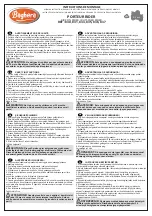
LOSI 8IGHT • INSTRUCTION MANUAL
10
EN
Binding and Calibrating the Receiver
Changing the Travel Adjust Settings
Maintenance and Trouble Shooting
In order to operate, the receiver must be bound to the transmitter. Binding is
the process of programming the receiver to recognize the GUID (Globally Unique
Identifier) code of a single specific transmitter. When a receiver is bound to
a transmitter/model memory, the receiver will only respond to that specific
transmitter/model memory.
You must calibrate the receiver each time it is placed in bind mode.
IMPORTANT:
The following sequence of steps must be followed in order for AVC to
function properly.
1. Insert the Bind Plug in the BIND port on the receiver.
2. Power on the receiver. The orange LED fl ashes, indicating the receiver is in bind
mode.
3. Center the ST TRIM and TH TRIM on the transmitter.
4. Put your transmitter in bind mode.
5. The bind process is complete when the orange LED on the receiver is solid.
6. Pull the transmitter trigger to Full Throttle, ,then return the trigger to center.
7. Push the transmitter trigger to Full Brake, then return the trigger to center.
8. Turn the transmitter steering wheel to Full Right, then return the steering wheel
to center.
9. Turn the transmitter steering wheel to Full Left, then return the steering wheel to
center. The orange LED fl ashes once.
10. Remove the bind plug once the calibration and binding process is complete.
11. Power off the transmitter.
IMPORTANT:
You must rebind the transmitter and receiver if you:
•
Change the servo reverse after binding
•
Change the travel after binding
•
Want to use the receiver with a different model memory
If you change the servo reversing or travel adjust after binding, AVC will not work
properly.
Disabling the Stability Assist Function
If you participate in organized racing, you may be required to turn AVC technology
off. To turn off AVC technology, insert a second Bind Plug in the Disable port before
binding.
IMPORTANT:
You must calibrate the receiver each time it is placed in bind mode. To
activate AVC, see the steps in BINDING AND CALIBRATING THE RECEIVER.
Failsafe
In the unlikely event that the radio connection is lost during use, the receiver will
drive the servos to their pre programmed failsafe positions (normally no throttle and
straight steering).
If the receiver is powered on before powering on the transmitter, the receiver will
enter this failsafe mode. When the transmitter is powered on, normal control is
resumed.
IMPORTANT
: Failsafe activates only in the event that signal is lost from the
transmitter. Failsafe will NOT activate in the event that receiver battery power
decreases below the recommended minimums or power to the receiver is lost.
The travel function supports precise endpoint adjustments in each direction for the
steering and throttle channels.
1. Hold the trigger in the full brake position and steering wheel in the full right
position while powering on the transmitter. The LED fl ashes rapidly, indicating the
programming mode is active.
2. Throttle End Point: Hold the trigger in the full throttle position. Turn the TH TRIM
knob to adjust the full throttle end point.
3. Brake End Point: Hold the trigger in the full brake position. Turn the TH TRIM
knob to adjust the full brake end point. Return the trigger to the center position.
4. Left Steering End Point: Hold the steering wheel in the full left position. Turn the
ST TRIM knob to adjust the left end point.
5. Right Steering End Point: Hold the steering wheel in the full right position. Turn
the ST TRIM knob to adjust the right end point. Return the steering wheel to the
center position.
6. Power off the transmitter to save the travel adjust settings. The minimum travel
is 75% and the maximum travel is 150%. The default travel settings are 125%
steering and 100% throttle.











































